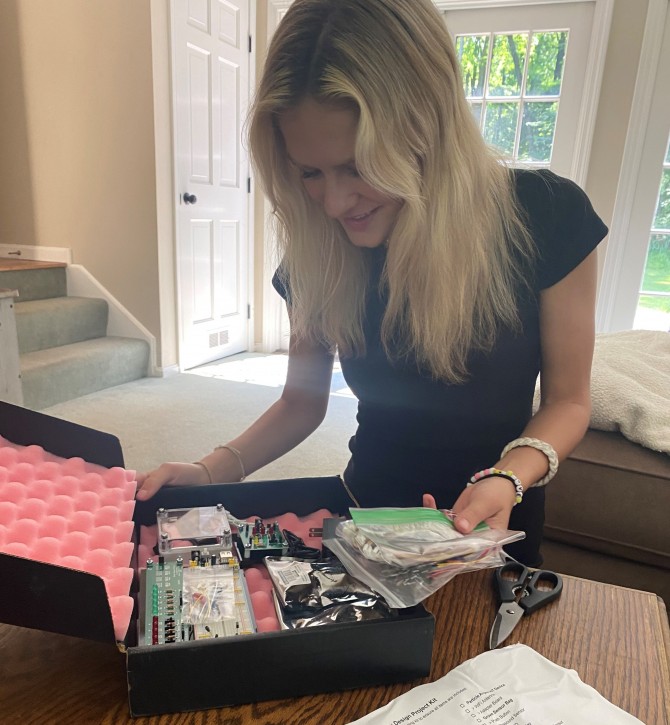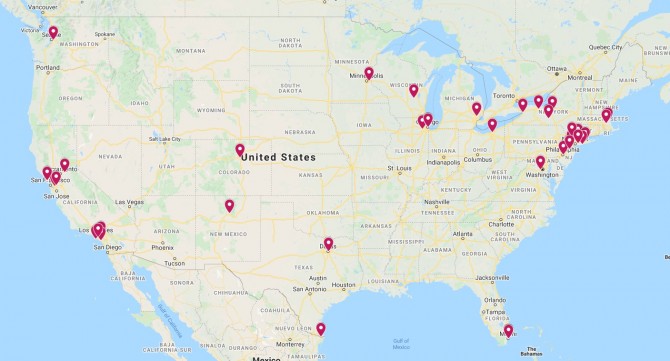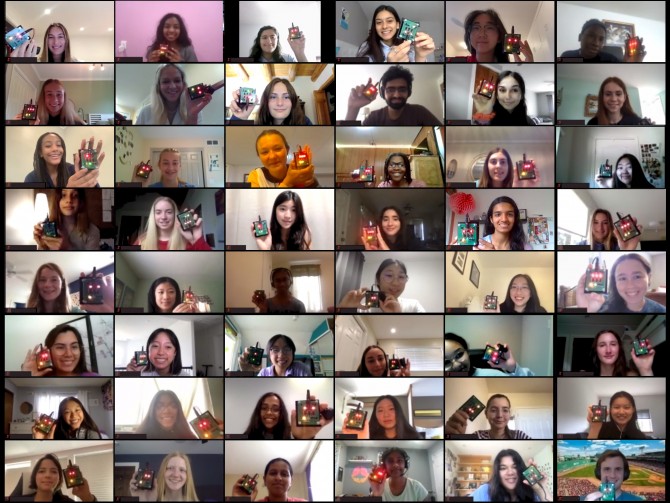
A group of CURIE Academy scholars demonstrating their prototype of a one-bit digital adder using Boolean logic gates.
News directly from Cornell's colleges and centers
DPE puts its mission into practice with CURIE Academy
By Eric Laine
Despite being scattered across the country, 43 high school juniors and seniors teamed up remotely from July 19-23 to build an interconnected system of hardware and software as part of Cornell Engineering’s annual CURIE Academy. The program, held entirely virtually this year due to the pandemic, offers high school students who excel in math and science the opportunity to explore engineering and embodies Cornell Engineering’s commitment to fostering more diverse and inclusive learning environments.
For this year’s CURIE Academy, Cornell’s Office of Diversity Programs in Engineering (DPE) worked with Christopher Batten, associate professor in the school of electrical and computer engineering (ECE), and a team of undergraduate and graduate teaching and program assistants to create and execute a unique program focused on the Internet of Things (IoT). Participants worked on a project designed by Batten titled Computing at the Edge, and nine engineering faculty members held additional sessions introducing the CURIE scholars to various fields of study within Cornell Engineering.
“The goal is to expand opportunities for students interested in engineering,” said Cindy Mosqueda, associate director of DPE. “We know there's a lot of inequality in students’ access to learning about engineering fields and computer science, and we want to make a little dent in that.”
Klara Thelusma, a CURIE Academy scholar and rising senior from Copiague, NY, commented about the important role the program plays in creating these opportunities. “It was really eye opening to see other girls interested in engineering,” Thelusma said, “especially since it's not that common in my town and surrounding area.”
Mosqueda said the program is intended to inspire students to consider engineering as a college major and potentially as a career. Many of the students who attend CURIE Academy later become Cornell Engineering students, and some who were scholars in the program have returned to offer support as teaching assistants or program assistants.
Hands-On Project
Being entirely remote provided some unique challenges and opportunities for a hands-on project-based program. Professor Batten, working with staff from DPE and ECE, assembled and shipped kits containing a variety of digital electronics prototyping equipment to each scholar.
"The design project was a tremendous success,” Batten said. “I was thoroughly impressed with how much the scholars were able to accomplish in just one week, especially given the remote learning environment.”
Scholars were able to prototype digital circuits using breadboards and were able to build simple IoT systems while collaborating with other scholars across the country. “I really do think we were able to turn the remote learning environment from a disadvantage into a unique opportunity to explore emerging IoT systems,” Batten said.
This feat was accomplished with the help of student teaching assistants who guided the scholars as they assembled their projects using tools like Zoom breakout rooms and Slack group messaging.
The week began with preliminary laboratory sessions focused on computer engineering from both the hardware perspective, assembling basic logic gates to implement a simple “calculator” for adding small binary numbers, and the software perspective, incrementally programming a microcontroller in C++ to implement an IoT “smart light” system.
Scholars transitioned to working in small groups on an IoT system centered around one of several themes, including smart home, early disaster warning, wearable health monitoring and digital agriculture. Each group of scholars independently designed their IoT system by choosing appropriate input sensor modules and output display modules, programming their IoT devices, and then interconnecting these devices through a cloud-based dashboard.
The scholars’ final projects included a network-connected security system, a hurricane and flood warning system, an adjustable social distancing “space bubble” system and a crop monitoring system.
Former scholars become mentors
One indicator of the CURIE Academy’s success is the number of former participants who return as mentors. Neha Malepati ’24, a sophomore computer science major and former CURIE Academy scholar, reached out to Cindy Mosqueda early this year to join the program as a teaching assistant. “I really wanted to be involved,” Malepati said, “Because [CURIE Academy] created such a huge impact on me, I wanted to give back to that community.”
Malepati knew she wanted to join Cornell Engineering after she discovered CURIE Academy as a high school student. “I realized that engineering isn't like what I experienced in high school. Cornell Engineering had such a positive environment,” Malepati said. “I knew that if I came to Cornell, I would experience that positive environment again.”
As a TA, Malepati’s role was to guide the CURIE scholars through the labs, helping to debug issues, brainstorm ideas and answer questions while generally creating an environment in which everyone felt empowered to ask questions.
“There were some points where I think, at least in the beginning, they were maybe a little bit afraid to ask for help because they didn't want to say anything to publicly disrupt the meeting,” Malepati said. This is an issue that repeatedly arises in educational settings where women find themselves in the minority.
Malepati tried to create the same kind of open and encouraging environment that she had experienced as a CURIE scholar. “My teaching assistants and program assistants really made that program for me,” Malepati said. “They were a big part in creating that welcoming environment. Reflecting on my experiences, I knew I wanted to be able to pay that forward.”
Molly Brakewood ’24, a sophomore majoring in biomedical engineering, served as a program assistant for CURIE Academy, monitoring the scholars’ well-being throughout the program. To keep students engaged, program assistants planned and led online team-building activities including games and icebreakers. They served as supportive role models and answered questions about Cornell, engineering, and college in general.
“Being a former CURIE scholar, I could think back on what I wanted out of my experience and provide that for this year’s participants,” Brakewood said. “I could anticipate the kinds of questions they had and how they might be feeling as they were exposed to new topics.” Brakewood tried to make this year’s virtual CURIE Academy feel as similar as possible to the in-person experience that she had in 2019.
Professor Batten was overwhelmed by the enthusiasm and skill the student assistants brought to the program. "My teaching assistants were amazing,” he said. “They really rose to the challenge of a remote learning environment and were continuously interacting with scholars via online messaging, helping to debug projects via Zoom, and bringing a positive and encouraging energy to the entire week.”
Along with Neha Malepati, undergraduate students Guadalupe Bernal, Ruyu Yan and Tito Maresca, along with graduate students Nick Cebry and Shreyas Patil, and recent ECE graduate Sabrina Herman ’21 served as teaching assistants for the design project portion of this year’s CURIE Academy.
Chrissy Nguyen, a CURIE scholar who is a rising junior from Quincy, MA, confirmed that their efforts had the desired effect. “It is really empowering to see and meet other girls who share a passion for engineering,” Nguyen said.
Creating an impact
Raina Kikani ’23 is a junior majoring in biomedical engineering who attended CURIE Academy in 2017. She described the program as critical to her academic development.
“CURIE gave me a push at an exceptionally formative time, Kikani said. “Prior to CURIE, I was unsure about my place in engineering and I was very anxious about applying to college. CURIE was an opportunity to prove to myself that I could attend an elite institution, learn despite challenges and enjoy myself through it all.”
Like Kikani, Molly Brakewood was frustrated by the lack of opportunities for engineering experience in high school. CURIE Academy provided the missing pieces.
“I was interested in the idea of engineering but had no real experience and didn’t know if I would actually enjoy it in practice,” Brakewood said. CURIE Academy offers field sessions outside the main design project covering different engineering majors, allowing scholars to evaluate which fields they found the most interesting. “After working hands-on in a CURIE Academy lab, I was sure that biomedical engineering was what I wanted to pursue.”
“I learned more in that week than I had in a year of high school science courses,” Kikani said of her CURIE Academy program. “As we met with more female professors and my cohort became closer, I was inspired and assured of my place in engineering.”
Now Kikani is working in the Cosgrove Lab as an undergraduate researcher. This summer, Brakewood began working with the Andarawis-Puri lab, the same lab that led the research project when she was a CURIE scholar.
Fulfilling the Mission
DPE staff, including High School Programs Coordinator Andrea Robinson, Ph.D. student in biomedical and biological science, work to create programs like CURIE Academy to make an impact on the overall diversity of women, underrepresented minorities and first-generation students in Cornell Engineering. Data from the past few years shows that it’s working. 88% of CURIE Academy scholars go on to choose a STEM field as a college major, and 57% of CURIE alumnae admitted to Cornell matriculate.
Cindy Mosqueda said that over the years CURIE scholars had expressed to her that often they were the only female students in their advanced math and science, high school robotics or computer science classes. “CURIE Academy may be one of the first times that the scholars are in a space where it's all students who look like them,” Mosqueda said. “We want them to be able to see themselves as future engineers and computer scientists.”
By the end of the program, CURIE scholars have a lot of excitement about their next steps. In a group chat during the final presentations in which each project team shared their accomplishments, the young women expressed their hopes to stay connected and their aspirations for future engineering degrees.
Chae Yeong Kim, a rising senior from Vienna, VA said she had been thinking about computer science. “But now I’m now really interested in computer engineering, because it combines both software and hardware, which I find fascinating,” she said.
Another CURIE scholar, Sophia Verwoert, a rising junior from Bayside, NY, said, “Not only did I learn so many new things about engineering, but I am also so thankful for the opportunity to connect with all the other scholars.”
As they approach the start of the next school year, Mosqueda hopes each scholar now has some extra confidence. “Hopefully, it's given them additional drive and motivation to know that they can succeed as engineers, and this is a path for them,” she said.
Now as a Cornell Engineer herself, former CURIE scholar Neha Malepati reflects on the challenges she and her fellow scholars faced and enjoys a sense of belonging and accomplishment.
“Every issue the scholars ran into, I ran into myself,” Malepati said. “And even though it was very frustrating for me in the moment, it ultimately helped me. That's the satisfaction you get with engineering. When you make the final product and you're actually able to share it with the world, that’s a sense of satisfaction that you can't get anywhere else.”
CURIE Academy is supported by alumni donors Han-Yan Lo ‘98, Elaine Tam ‘98, Harvey Willensky ’71 & Margie Willensky, Robert L. Ryan ’68, and other Cornell Engineering alumni. This year’s IoT design project is also supported by a grant from the National Science Foundation and an equipment donation from Particle Industries.
Media Contact
Get Cornell news delivered right to your inbox.
Subscribe




